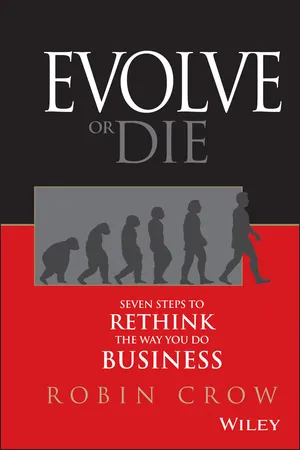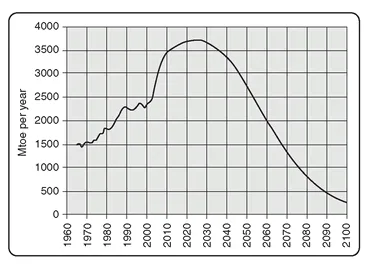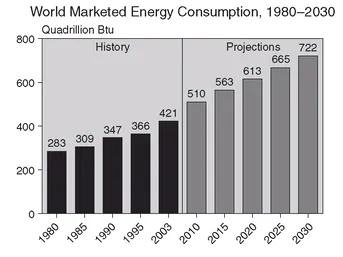
This is a test
- English
- ePUB (mobile friendly)
- Available on iOS & Android
eBook - ePub
Book details
Book preview
Table of contents
Citations
About This Book
Bring positive change and attain the highest levels of success
Robin Crow has years of experience working in the trenches as an entrepreneur and business owner. Now he has put all that work at your disposal with his unique Seven Step Challenge. Presented as a call to action, Evolve or Die delivers optimistic solutions to become better than you were yesterday and realize abundance at every level for personal and professional growth. The method teaches
- Exceed expectations
- Gets things done
- 100% accountability
- Commit to continual improvement
- Boundless optimism
- Environmental responsibility
- Make a difference
Whether you're the CEO or cleaning the CEO's office, by following the author's program you'll be able to regain control, refocus, and bring positive change to attain the highest levels of success.
Frequently asked questions
At the moment all of our mobile-responsive ePub books are available to download via the app. Most of our PDFs are also available to download and we're working on making the final remaining ones downloadable now. Learn more here.
Both plans give you full access to the library and all of Perlego’s features. The only differences are the price and subscription period: With the annual plan you’ll save around 30% compared to 12 months on the monthly plan.
We are an online textbook subscription service, where you can get access to an entire online library for less than the price of a single book per month. With over 1 million books across 1000+ topics, we’ve got you covered! Learn more here.
Look out for the read-aloud symbol on your next book to see if you can listen to it. The read-aloud tool reads text aloud for you, highlighting the text as it is being read. You can pause it, speed it up and slow it down. Learn more here.
Yes, you can access Evolve or Die by Robin Crow in PDF and/or ePUB format, as well as other popular books in Personal Development & Personal Success. We have over one million books available in our catalogue for you to explore.
Information
PART I
Something’s Has to Give
1
Who Are You Listening To?
The Circus Is Coming to Town
On June 26, 2007, two Ethiopian soldiers were killed and two wounded in a roadside bombing in Mogadishu. On that same day, the Energy Department announced that it was creating three bio-energy research centers in an effort to find new ways to turn green plants into fuel.
But if you had been watching TV that day—no matter what channel you turned to—you would have found Paris Hilton to be the main event. Was she the sole survivor of an airplane crash? Had she discovered a cure for cancer? Did she donate a million dollars to start a homeless shelter? Not by a long shot. Hilton had been released from jail after serving a 20-day sentence for violating her probation in a drunken driving case. Waiting outside of L.A.’s Century Regional Detention Facility was a crush of paparazzi giving her the kind of attention you might expect for the President or the Pope; indeed, a full-fledged media circus.
It’s All About the Ratings
Why do CNN and Fox News broadcast absurd events like Hilton’s antics? In a word: ratings. These media outlets know that drama sells, and therefore decide what to air based not on real relevance or genuine importance, but on what will keep viewers tuned in and turned on. If you have a big mouth, strong opinions, and a flair for the dramatic, you just might have a career in television; just ask Ann Coulter, Rush Limbaugh, Keith Olbermann, or Bill Maher. Though I’m often amazed that people take them seriously, you’ve got to give them credit: they know that the louder they shout—the more argumentative, over-the-top, and controversial they are—the higher their books will climb on the bestseller lists, and the more viewers they’ll grab. The “news” we get from watching television, mass-market books, or the Internet is compromised because the bottom line is that every news program lives or dies by ratings, and drama—trivial though it may be—drives ratings.
The Approaching Perfect Storm
Back in the real world, however, there is a convergence of truly threatening issues—that will affect your business, family, and quality of life—and that convergence is building momentum. Accelerating population, diminishing natural resources, increasing demand for energy, and our teetering environment are all ticking time bombs, even if they are not yet dramatic enough to merit primetime news coverage.
All four of these real issues will have far-reaching implications for the way you conduct business going forward. These are not conspiracies or best-kept secrets; all are the subject of countless books, magazine articles, and documentaries. Put them all together, and you have a perfect storm that cannot be ignored; yet that’s exactly what the mainstream media (and our society) seems to be doing. We’re like an ostrich that puts its head in the sand when danger is approaching; not too smart for the ostrich, or your business, either.
Living in a Bubble
Just last week I got a haircut from a delightful young woman whom I had never met before. She seemed bright, friendly, outgoing, and inquisitive, asking me one question after another. Once I told her that I was an author, she responded by asking, “What kind of books do you write?” I began telling her about a book I was currently writing (the one you are reading now), which delves into several critical issues that we are all going to have to face—particularly in business. I then inquired whether any of these challenges were of concern to her, and her response was, “No, I just live in my own little bubble and hope that everything will be okay.” I realized her sentiments likely represent the views of most “average” Americans—happy to remain unaware and blissfully ignorant of severe and impending situations until they are personally affected. Well, that time is now, whether they know it or not.
Taking into consideration the many current global issues, savvy business leaders are starting to recognize that in order to succeed in the twenty-first century, we have no choice but to evolve or die.
Whether we choose to acknowledge it, we live and work together on a small planet that’s interconnected in many complex ways—many of which even experts don’t fully understand. We are at the beginning phases of an unprecedented turning point in all of human history with the convergence of four global issues—all taking place simultaneously. These issues—which I list and briefly explain below—will most certainly impact your business and therefore deserve your fullest attention. Your understanding of how to adapt your business to these four challenges will be crucial to your company and your career’s success, and will determine which opportunities lie ahead.
1. Overpopulation
2. Diminishing natural resources
3. Global need for more energy
4. Environmental damage
The best time to plant a tree is 20 years ago. The second best time to plant a tree is today.
—African Proverb
Overpopulation
Overpopulation is an incredibly dire yet oft-ignored issue. The problem is not just the number of people on the planet, but their “per-capita impact” on the environment each person has—particularly in highly developed countries like the United States. Citizens in developed nations consume 32 times more resources and create 32 times more waste than those living in third-world countries.
There were only 3 billion people living on this planet in 1959. By 1999—40 years later—the population had doubled to 6 billion. Most population experts agree that by 2040, there will be some 9 billion people all sharing the same limited air, water, energy, and other natural resources. (See Figure 1.1) Though the planet hasn’t gotten any bigger or richer in resources in the past half century, it has gotten exponentially more populated. There is no one who will not be affected by this; you and your business will be operating in an overcrowded world and will have to cope with growing populations that will need clean air, clean water, food, jobs, housing, and health care.
Figure 1.1 POPULATION GROWTH CONTINUES.
As the earth’s population continues to climb, our natural resources on which every business depends are diminishing. As we squeeze in the next 3 billion people, only those businesses that are highly efficient and highly evolved will survive.
Source: U.S. Census Bureau, International Data Base, June 2009 update (www.census.gov/ipc/www/idb/worldpopgraph.php).

In 1968, Paul Ehrlich’s best-selling book The Population Bomb warned us of what would happen if the world population kept growing at the same pace. The book was a popular item for discussion on the cocktail party circuit back in the 1960s, but you’d be hard-pressed to find much reporting on cable TV or other current news sources about what may be a disaster for the whole of human kind. Occasional dribbles and dabs, perhaps, but certainly no front-page headline grabbing or sustained news reporting. It’s a story that seems to have gone away, news-wise, even though the population clock is indeed still ticking.
How much human life can the Earth sustain ... in terms of the ratio of population to available sustainable resources? Experts all over the world are grappling with this question. More important to you: how will this affect your business? In short, you will have to find creative ways to accomplish more with less. For instance, CEOs of automobile manufacturing companies would be wise to be standing by with smaller, more fuel-efficient car designs.
Diminishing Resources
A growing population will inevitably require more food, space, water, energy—and virtually every other natural resource. Yet when we look at the data, it becomes alarmingly apparent that our natural resources have already begun a downward spiral.
We must consider what will happen when less-developed countries begin to experience dwindling resources past a tolerable threshold, or when countries that have managed to develop nuclear weapons can’t feed their populations or keep the lights on. Resource wars will break out when things get bad enough.
In order to thrive in coming years, we all have to educate ourselves on how diminishing resources will impact business—and then create a strategy to deal with that fact. The more aware you are of the global changes taking place, the better your chances of continued success.
—Jim Rohn
Global Need for More Energy
Global energy demand is estimated to increase 58 percent over the next 25 years; and that power has to come from somewhere in order for civilization as we know it to thrive. Renewable energy is still in its infancy, and although the use of solar, wind, and other renewable resources is growing, we still use mostly fossil fuels—oil, coal, and natural gas—which are beginning to diminish (See Figures 1.2, 1.3 and 1.4.) There is no magic bullet that will solve our energy dilemma, and we’ll likely consume anything we can get our hands on for the next two or three decades. But then what?
The more your business depends on energy, the more vulnerable you will be as energy prices continue to rise. My local electric company has raised the rates for my company’s recording studio complex 14 percent in the last year—which has given us an incentive to find ways to be more efficient. We’ve taken some drastic measures to use less electricity, thereby lowering our bills and our carbon footprint at the same time. One of the biggest kilowatt users is our million-dollar collection of mixing consoles, recording gear, and power amps, all of which generate a lot of heat. Conventional wisdom says they must be left on 24 hours a day, and kept cool with air-conditioning whether the studios are in use or not. Going against what all the “experts” advise, I decided to turn off all equipment that wasn’t being used and shut off the air-conditioning in those rooms. I’ve been around this type of equipment my entire life, and concluded that this was a risk worth taking. I’m happy to say not one piece of equipment—or client—has suffered. We’ve also gone to great lengths to insulate our buildings and seal up every window and door to make them practically airtight. And yes, our electric bill has gone down, and future price increases—which will certainly happen—will affect us less and less. (See Figure 1.5.)
Figure 1.2 OIL BECOMING SCARCER.
These next three graphs show that energy is the key limiting natural resource that threatens economic growth. We have probably already passed the “peaks” in extracting oil, gas, and even coal, which is impacting your business right now.
Source: http://canada.theoildrum.com/node/3091.

Figure 1.3 GAS BECOMING SCARCER.
Source: http://canada.theoildrum.com/node/3091.

Figure 1.4 COAL BECOMING SCARCER.
Source: http://canada.theoildrum.com/node/3091.

Your electric bill has no place to go but up as global energy demand continues to grow, so start figuring out how to reduce that and other energy bills. Are there things you’ve deemed “necessary” that really are not? Are there areas where you can save energy and money, or somehow combine resources? Whether you’re a mammoth company like Walmart or a small start-up, there are countless actions you can take to heighten your efficiency.
Figure 1.5 ENERGY CONSUMPTION INCREASES. As energy usage continues to increase, energy costs are rising faster than incomes. The more consumers spend for energy, energy alternatives, and even energy efficiency, the less consumers have to spend on everything else.
Sources: History—Energy Information Administration (EIA), International Energy Annual 2003 (May-July 2005), www.eia.doe.gov/iea . Projections—EIA, System for the Analysis of Global Energy Markets (2006). From http://timeforchange.org/prediction-of-energy-consumption.

Your business doesn’t use much energy, you say? There are hidden energy costs about which most businesses aren’t fully aware. For example, Amazon.com sells books that are delivered to customers via UPS or FedEx, whose planes and trucks need jet fuel and diesel—and lots of it. At some point, the cost of shipping those books may be too high a price to pay; only the market can decide that. But the recent introduction of the electronic book reader “Kindle” and the “Tablet” allows Amazon to ship you the content electronically for one-ten-thousandth of the energy cost of mailing the paper version (not to mention the savings in trees). Amazon is looking toward the future and adjusting its business model to be less sensitive to UPS and FedEx shipping costs. What can your business do?
Fragile Environment
You can’t operate a profitable fishing business if there are no longer fish in the ocean, and you can’t be a successful farmer if your soil can no longer supply the nutrients needed to produce a bountiful crop. You can’t run a successful printing business if paper costs keep skyrocketing because trees for producing pulp are in short supply. Be it oil, silicon chips, or copy paper—just about every material your business uses comes from nature and is in limited supply. (Silicon chips are made from sand, which admittedly is plentiful, but it requires a huge amount of energy to turn plain sand into pure silicon.) It therefore makes good business sense to incorporate protecting our fragile environment into your business model so that your company can grow and prosper.
Our impact on the planet has grown by exponential...
Table of contents
- Title Page
- Copyright Page
- Dedication
- Acknowledgments
- About the Author
- Introduction
- PART I - Somethingâs Has to Give
- PART II - Seven-Step Challenge
- 30-Day Pledge
- Now Is the Time
- Resources